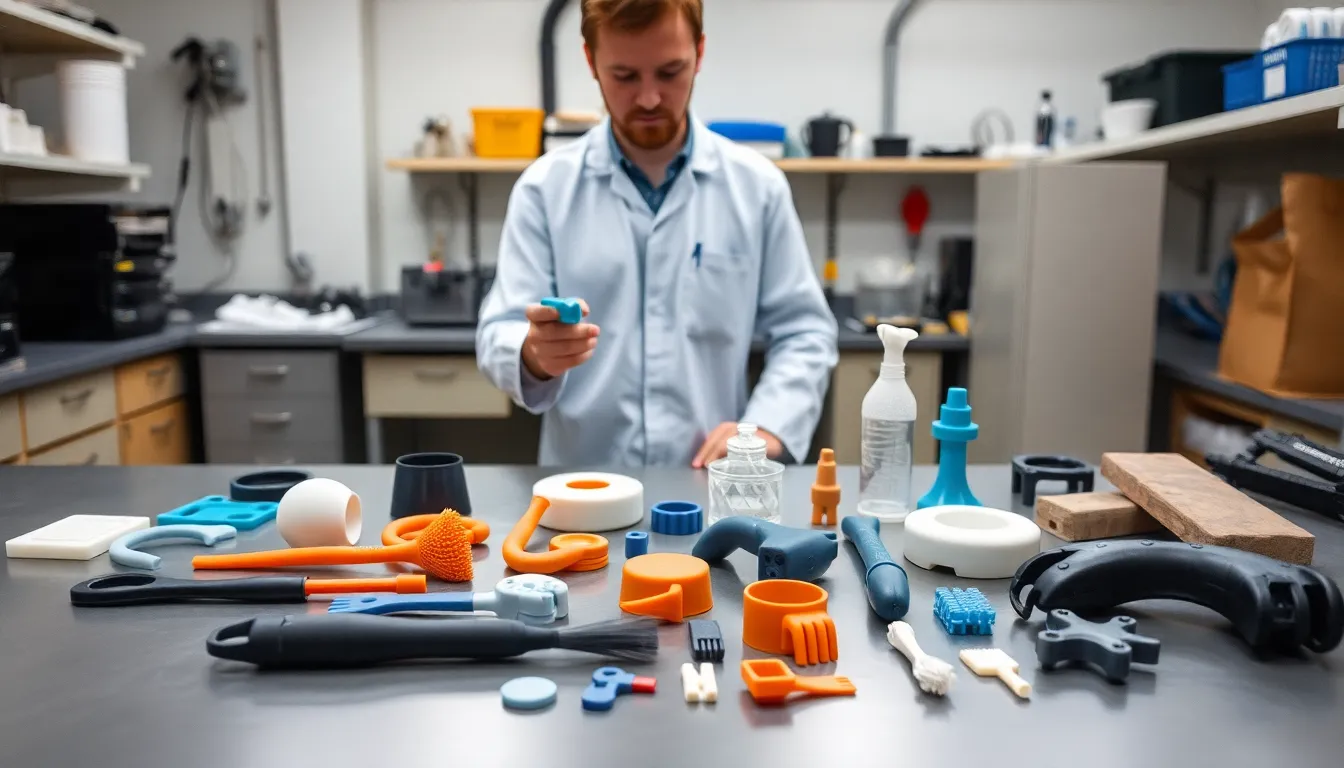Imagine a world where creativity knows no bounds and your wildest ideas can spring to life faster than you can say “3D printing.” Enter the realm of 3D printing silicone, where flexibility meets innovation in a way that even your favorite superhero would envy. This cutting-edge technology allows designers and engineers to craft everything from custom prosthetics to quirky kitchen gadgets, all while having a bit of fun along the way.
Gone are the days of rigid materials and boring designs. With 3D printed silicone, the possibilities are as limitless as your imagination. Whether it’s creating a soft, squishy toy or a sleek, functional part, this game-changing material promises to revolutionize industries. Buckle up as we dive into the fascinating world of 3D printing silicone and explore how it’s reshaping the way we think about manufacturing and design.
Table of Contents
ToggleWhat Is 3D Printing Silicone?
3D printing silicone involves the use of specialized techniques to create flexible and durable products. This process utilizes liquid silicone rubber (LSR) that’s heated and cured, allowing for intricate designs. The unique properties of silicone enable the production of items like custom molds, wearable devices, and even automotive parts.
Additive manufacturing plays a crucial role in producing silicone items. Unlike traditional methods, 3D printing focuses on building objects layer by layer, which allows for rapid prototyping and customization. Manufacturers can create components tailored to specific needs, reducing waste and production time.
Flexible and resilient, 3D printing silicone retains its shape while offering stretchability. This makes it ideal for applications requiring high elasticity and strength. Common uses include medical products, consumer goods, and specialized industrial parts.
Different types of silicone can be used in 3D printing processes. High-performance silicones offer enhanced temperature resistance, while standard silicones provide cost-effective solutions. Selecting the appropriate type often depends on the intended function of the final product.
Various 3D printing technologies apply to silicone. Techniques like direct ink writing (DIW) and fused deposition modeling (FDM) are popular methods suited for silicone materials. Each method possesses unique advantages, making it essential to choose based on design requirements and production scale.
The future of 3D printing silicone looks promising. Ongoing advancements in materials and techniques will continue to expand its applications, impacting industries from healthcare to fashion. This innovative technology not only enhances creativity but also improves efficiency in design and manufacturing processes.
Benefits of 3D Printing Silicone

3D printing silicone offers significant advantages, enhancing production methods across various sectors. Its unique properties make it suitable for multiple innovative solutions.
Versatility in Applications
Applications of 3D printed silicone span numerous industries. Medical professionals use silicone for custom prosthetics, ensuring a precise fit for patients. In consumer goods, designers create flexible kitchen tools such as spatulas and molds, improving user experience. Automotive manufacturers incorporate silicone into gaskets and seals, enhancing the durability of components. Fashion designers explore wearable technology by integrating silicone elements into clothing, paving the way for new aesthetic possibilities. Each application showcases the material’s adaptability, supporting diverse creative processes.
Cost-Effectiveness
Cost-effectiveness emerges as a major benefit of 3D printing silicone. Traditional manufacturing methods often entail high material waste and labor costs, while 3D printing significantly reduces both. Customization leads to lower production runs, avoiding excessive inventory expenses. Businesses can employ rapid prototyping to test designs before mass production, minimizing the risk of costly errors. Utilizing liquid silicone rubber streamlines production, lowering per-unit costs. Organizations benefit from quicker turnaround times, translating to faster market entry and increased profitability.
The Process of 3D Printing Silicone
3D printing silicone involves several key stages, starting with material preparation and followed by the application of specific printing techniques. Understanding these steps ensures efficient and effective use of silicone in various products.
Preparation of the Material
Material preparation begins with selecting the appropriate liquid silicone rubber (LSR) based on the desired properties. Professionals mix LSR with curing agents to initiate the chemical process that transforms the liquid into a solid. This mixture often undergoes vacuum degassing to eliminate air bubbles, which can compromise product quality. After that, the prepared silicone must be loaded into the 3D printer, ensuring it is ready for precise deposition.
Printing Techniques Used
Direct ink writing (DIW) remains a prominent method for 3D printing silicone. This technique utilizes a nozzle that deposits the silicone layer by layer, creating complex geometries. Fused deposition modeling (FDM) may also be applied, allowing for ease of use with thermoplastic materials. Both methods provide flexibility in design while maintaining product integrity. Each technique contributes to the unique advantages of 3D printed silicone, catering to diverse industry demands.
Common Applications of 3D Printing Silicone
3D printing silicone serves various industries, showcasing its versatility through numerous applications.
Medical Devices
Medical devices represent one of the most significant applications of 3D printing silicone. Custom prosthetics cater to individual patient needs, ensuring a perfect fit and enhanced comfort. Surgeons utilize silicone models for preoperative planning, improving surgical outcomes. Additionally, silicone’s biocompatibility allows it to be used in implants and wearable health monitoring devices. Rapid prototyping accelerates development time, enabling healthcare professionals to access innovative solutions quickly. Custom surgical guides enhance precision during procedures, further demonstrating silicone’s value in medical technology.
Consumer Products
Consumer products significantly benefit from the flexibility of 3D printing silicone. Designers create unique kitchen gadgets tailored to specific functions, such as non-slip mats and flexible molds. Footwear companies incorporate silicone for comfortable, customizable insoles. Other applications include phone cases that provide durability and grip. Early-stage prototyping allows designers to test products before mass production, reducing costs and improving functionality. The ability to produce low-volume runs of custom goods illustrates silicone’s potential within the consumer market.
Challenges and Considerations
3D printing silicone presents several challenges that require careful consideration. Material properties pose one of the biggest hurdles. Although silicone is known for its flexibility and durability, achieving the desired consistency can be difficult. Variations in material viscosity affect the printing process, often leading to inconsistencies in the final product.
Printing technology also plays a critical role. Direct ink writing and fused deposition modeling each have unique advantages but come with limitations. Direct ink writing offers excellent precision but often requires specialized equipment for effective layering. Fused deposition modeling, on the other hand, is more user-friendly but may not provide the same level of detail when working with silicone.
Another important factor is print speed. While 3D printing enables rapid prototyping, printing silicone can take longer than traditional materials. Adjusting layer thickness and print speed may enhance results but can increase production times. Manufacturers often need to find a balance between speed and quality, which can complicate the workflow.
Surface finish represents an additional consideration. Achieving a smooth, uniform surface can be challenging due to the nature of silicone. Post-processing techniques like sanding or coating may improve the appearance but add time and cost to the overall project.
Lastly, applications in sensitive areas like healthcare demand strict compliance with regulatory requirements. Medical-grade silicones must meet biocompatibility standards, complicating the material selection process. Thus, manufacturers must stay informed about industry regulations to ensure compliance.
Addressing these challenges ensures successful integration of 3D printing silicone into various applications, maximizing its potential across industries.
The potential of 3D printing silicone is reshaping various industries by offering innovative solutions and enhancing creative possibilities. With its unique properties and versatility, silicone is becoming a go-to material for custom applications in healthcare, consumer goods, and automotive sectors.
As advancements in technology continue to emerge, the challenges associated with material consistency and regulatory compliance are being addressed, paving the way for broader adoption. This evolution promises not only to streamline production processes but also to inspire designers and engineers to explore new horizons in product development.
The future of 3D printing silicone holds exciting prospects, making it an essential area for those looking to stay ahead in design and manufacturing.



